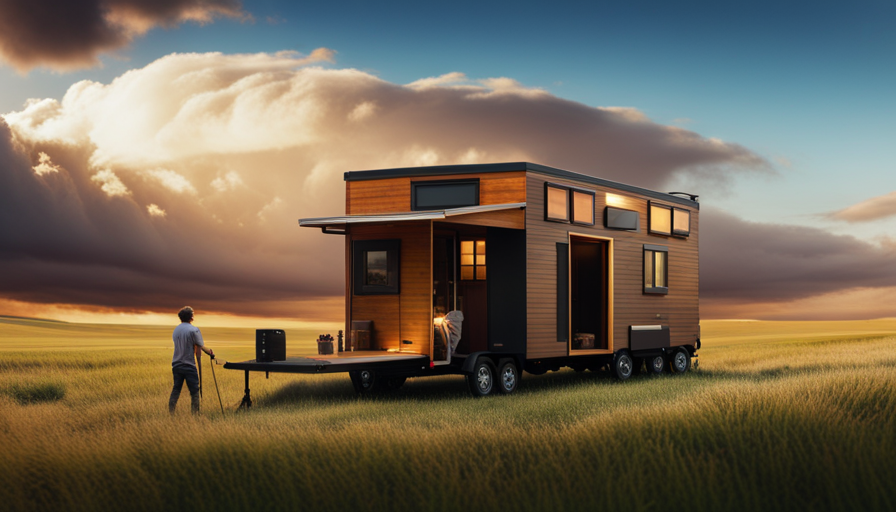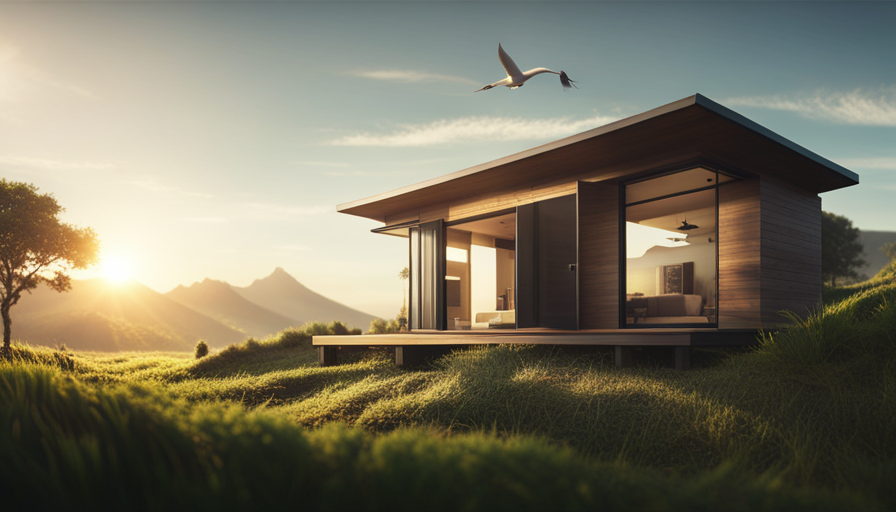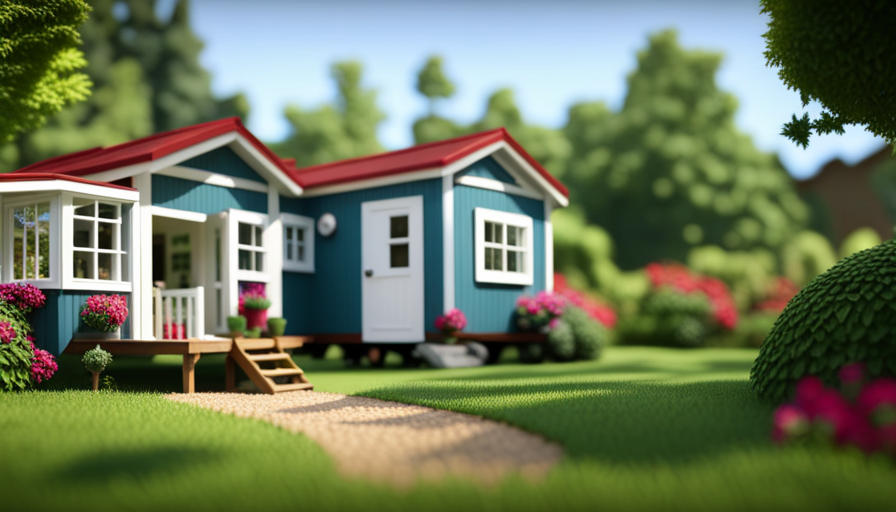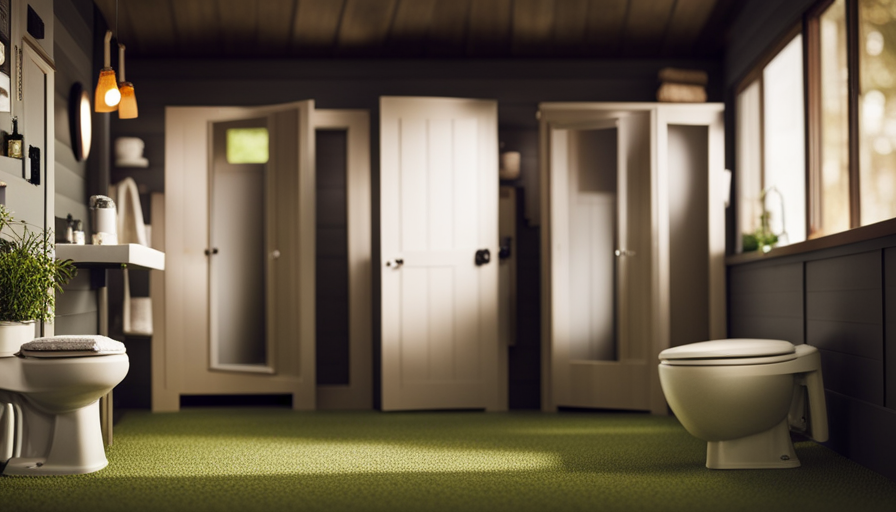In a world that can often feel suffocating and constricting, there is a growing movement towards embracing simplicity and freedom. People are seeking ways to break free from the confines of consumerism and adopt a minimalist lifestyle. At the forefront of this movement are tiny houses, symbolizing independence and self-sufficiency. These compact homes have captured the imagination of many, offering the opportunity to live a nomadic existence while discovering new landscapes.
But just how big can a tiny house be and still maintain its mobility? In this article, I will explore the legal restrictions, dimensions, weight limits, and design considerations that come into play when taking a tiny house on the road. From compact layouts and lightweight materials to storage solutions and reliable towing vehicles, we will delve into the intricacies of creating a home that is both cozy and portable.
So, let’s embark on this journey together as we discover just how big a tiny house can truly be.
Key Takeaways
- Researching parking regulations and height restrictions is essential when designing a tiny house for road travel.
- Maximizing interior space with multi-functional furniture and storage solutions is crucial in designing a compact layout for mobility.
- Energy efficiency and natural lighting should be prioritized in tiny house design to reduce reliance on external power sources.
- Investing in a reliable towing vehicle with sufficient towing capacity and fuel efficiency is necessary to ensure a smooth and safe travel experience.
Understanding the Legal Restrictions for Road Travel
You won’t believe the legal restrictions that could prevent you from taking your dream tiny house on the road! Understanding parking regulations and complying with height restrictions are crucial when it comes to traveling with a tiny house.
Parking regulations vary from state to state and even from town to town, so it’s important to research and understand the specific rules and regulations in the areas you plan to visit. Some places may have restrictions on where you can park your tiny house, while others may require permits or have time limits.
Additionally, height restrictions can also pose a challenge. Many roads and bridges have height limitations, so it’s important to ensure that your tiny house meets the maximum height requirements for road travel.
Determining the maximum dimensions for portability is the next step to consider when planning your tiny house adventure.
Determining the Maximum Dimensions for Portability
When it comes to hitting the highway with your compact abode, size limitations can really put a damper on your adventurous spirit. Determining the maximum dimensions for portability is crucial if you want to take your tiny house on the road.
One important factor to consider is the maximum weight that your house can be without compromising its structural integrity. This weight limit will depend on the materials used in construction and the strength of the foundation.
Additionally, you need to ensure that your tiny house meets the requirements for height, width, and length set by transportation authorities. By adhering to these limitations, you can safely transport your tiny house and enjoy the freedom of the open road.
Now, let’s delve into the next section about considering weight limits for towing.
Considering Weight Limits for Towing
Determining the maximum weight for towing is crucial if you want to hit the highway with your compact abode and experience true freedom. When it comes to tiny houses on wheels, weight limits are a major consideration. Evaluating the impact of weight distribution on towing capability is essential.
It is important to evenly distribute the weight throughout the trailer to maintain stability and prevent swaying during travel. Additionally, exploring the benefits of aerodynamic design for towing efficiency can greatly enhance the towing experience. By reducing wind resistance, an aerodynamic tiny house can improve fuel efficiency and make towing easier.
Considering weight limits and optimizing the design for efficient towing will ensure a smooth and hassle-free journey on the road. With these factors in mind, let’s now transition into the subsequent section about designing a compact layout for mobility.
Designing a Compact Layout for Mobility
To fully embrace the freedom of life on the open road, it’s time to get creative and design a compact layout that maximizes mobility in your tiny rolling abode.
When it comes to tiny house design, every inch counts. To maximize interior space, consider utilizing multi-functional furniture and built-in storage solutions. Think collapsible tables, lofted beds with storage underneath, and wall-mounted shelves. This will help you make the most of limited square footage and keep your belongings organized.
Additionally, optimizing energy efficiency is crucial for a mobile tiny house. Choose appliances that are energy-efficient and install insulation to regulate temperature. Utilize natural light with well-placed windows and skylights, reducing the need for artificial lighting during the day. These design choices will not only make your tiny house more comfortable but also help conserve energy.
Now, let’s explore the next step in designing your mobile tiny house: choosing lightweight materials for construction.
Choosing Lightweight Materials for Construction
Consider selecting lightweight materials for construction in order to create a mobile tiny home that’s both nimble and efficient. When it comes to choosing the right materials, there are a few options to consider. One important aspect is lightweight insulation. There are various types available that provide excellent thermal performance while minimizing weight. Some popular options include foam boards, reflective insulation, and natural materials like sheep’s wool or cellulose.
Additionally, eco-friendly construction materials should be prioritized. Sustainable options such as bamboo, reclaimed wood, or recycled metal can help reduce the environmental impact of your tiny home. These materials not only offer durability but also contribute to a healthier living environment. By using lightweight and eco-friendly materials, you can ensure that your tiny home isn’t only easy to tow but also environmentally conscious.
Transitioning to the subsequent section, investing in a reliable towing vehicle is crucial for a smooth and hassle-free journey.
Investing in a Reliable Towing Vehicle
Finding the perfect towing vehicle is like finding a needle in a haystack, but with thorough research and careful consideration, you can discover the ideal match for your mobile abode. When investing in a reliable towing vehicle for your tiny house, it’s important to prioritize fuel efficiency and maintenance costs.
To help you make an informed decision, here are a few key points to consider:
- Look for vehicles with high fuel efficiency ratings to save on long-term costs.
- Consider the maintenance costs of the towing vehicle, including routine maintenance and potential repairs.
- Research the towing capacity of different vehicles to ensure it can handle the weight of your tiny house on the road.
Investing in a fuel-efficient and low-maintenance towing vehicle won’t only save you money but also ensure a smooth and hassle-free journey. With the right vehicle in tow, you can now explore creative storage solutions for limited space.
Exploring Creative Storage Solutions for Limited Space
When it comes to maximizing storage in my mobile abode, I get inventive with clever solutions that make the most of limited space.
One of the best ways to save space is by investing in space-saving furniture. For example, a sofa bed not only provides seating during the day but also turns into a comfortable bed at night.
Another great option is a folding dining table that can be easily tucked away when not in use.
Additionally, I utilize creative organization techniques to keep everything in order. I hang storage pockets on the walls to store small items like keys, wallets, and phones.
I also use stackable containers to make the most of vertical space.
By incorporating these space-saving furniture and creative organization techniques, I’m able to have a clutter-free and functional living space in my tiny house on the road.
Frequently Asked Questions
What are the legal restrictions for road travel when towing a tiny house?
I know what you’re thinking – towing a tiny house on the road must come with a ton of legal restrictions, right?
Well, you’ll be surprised to know that there are actually minimal legal requirements for road travel with a tiny house. As long as your tiny house meets the size and weight limits set by your state’s Department of Transportation, you’re good to go.
However, it’s essential to have proper insurance coverage to protect your investment while towing.
How do I determine the maximum dimensions for portability of my tiny house?
When determining the maximum dimensions for portability of my tiny house, I need to consider several portability factors. These include the weight, height, and width restrictions set by transportation regulations.
Additionally, I should take into account the towing capacity of my vehicle and the size of the roads I plan to travel on. By ensuring that my tiny house dimensions adhere to these factors, I can ensure a smooth and hassle-free journey on the road.
What weight limits should I consider when towing a tiny house?
When considering towing a tiny house, it’s crucial to prioritize weight limits and towing capacity. These two factors dictate the maximum load your vehicle can safely handle. To ensure a smooth journey, consult your vehicle’s manual to determine its towing capacity.
It’s essential to stay within this limit to avoid putting unnecessary strain on your vehicle’s engine, brakes, and suspension. Overloading can lead to accidents and damage to your tiny house and vehicle.
How can I design a compact layout for my tiny house to ensure mobility?
To design a compact layout for my tiny house, I focus on maximizing space. I carefully consider the placement of furniture, appliances, and storage solutions.
By utilizing multi-functional furniture and clever storage options, I can create a layout that is both efficient and mobile. I prioritize open floor plans, utilizing vertical space, and incorporating built-in storage.
This way, I can ensure that my tiny house is not only compact but also offers ample room for movement and functionality.
What are some lightweight materials that can be used for construction of a tiny house?
When it comes to constructing a tiny house, using lightweight materials is key. From my personal experience, I’ve found that opting for sustainable materials not only reduces the overall weight of the house but also has numerous benefits.
Materials like bamboo, reclaimed wood, and recycled steel are not only lighter but also eco-friendly. They provide strength and durability without compromising on mobility. Incorporating these materials in your tiny house construction ensures a sustainable and lightweight home that can be easily transported.
Conclusion
In conclusion, when it comes to taking a tiny house on the road, there are several factors to consider.
From understanding the legal restrictions and maximum dimensions to choosing lightweight materials and investing in a reliable towing vehicle, it’s important to carefully plan and design your tiny house for mobility.
Additionally, exploring creative storage solutions will help maximize the limited space available.
Remember, in this case, size really does matter, so it’s crucial to stay within the limits to ensure a smooth and hassle-free journey.
As the saying goes, ‘good things come in small packages,’ and with proper planning, your tiny house can be the perfect road companion.
Hi, I’m Emma. I’m the Editor in Chief of Tiny House 43, a blog all about tiny houses. While tree houses are often associated with childhood, they can be the perfect adult retreat. They offer a cozy space to relax and unwind, surrounded by nature. And since they’re typically built on stilts or raised platforms, they offer stunning views that traditional homes simply can’t match. If you’re looking for a unique and romantic getaway, a tree house tiny house might just be the perfect option.
















